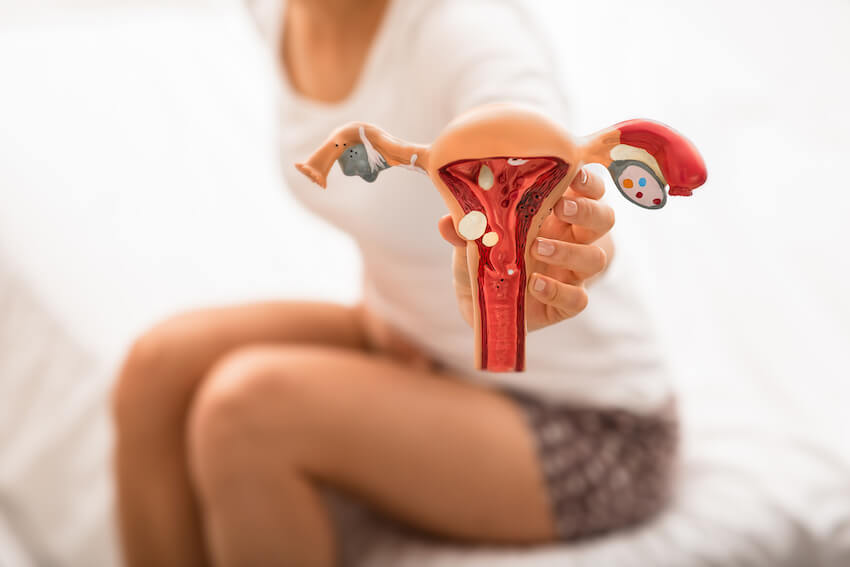What is Endometriosis?
Endometriosis is a common condition that requires a bit of understanding. Normally there is a uterine lining that is made of tissue which is shed off every month cyclically. When this uterine [endometrial tissue]is present outside the uterus ,in the abdomen, pelvis, sometimes even in the chest , this is called Endometriosis.
A few sites where endometriosis may develop are
- The outside and back of the uterus
- In ligaments like uterosacral ligaments which support the uterus
- Ovaries
- Fallopian tubes
- Peritoneum(the smooth lining of the abdomen and pelvis)
- Rectum
- Urinary bladder and ureters
- Diaphragm
- Some scars like those of Caesarean deliveries
So what happens due to these endometriotic implants?
During the menstrual periods, this tissue which is outside the uterus, also thickens and bleeds. However since it can’t escape from the abdomen or pelvis, it becomes trapped. This blood causes ovarian cysts to develop and tissue around it also liberates some inflammatory chemicals that cause irritation, leading to scar tissue and adhesions-fibrous bands that cause pelvic tissues and organs to stick to each other. This is a simplified version to describe the effects of endometriosis.

Who is liable to get endometriosis?
Most commonly endometriosis occurs in women in their reproductive years (25-45 years) but it can also happen in adolescents. People in the menopausal years may find relief but it may still cause some discomfort and pain
Are there any risk factors for endometriosis ?
Yes
This condition may be genetic and may run in families. It is also common if you have onset of periods early ,before the age of 11 years. More frequent periods, longer days of bleeding and defects in the structure of the uterus may make one more liable to get this condition. Never giving birth and a late menopause are also risk factors.
What are the symptoms that point to endometriosis?
Some people may have endometriosis and not have any symptoms. The severity of endometriosis is not related to symptoms though. You may have mild disease and severe symptoms or even the reverse.
Pain or dysmenorrhea during periods is the commonest problem. Pain may be in the lower abdomen, back and pelvis; related or unrelated to periods and fairly constant.
Feeling tired all the time is another symptom.
Painful intercourse
Spotting between periods or heavy menstrual bleeding
Infertility
Painful bowel movements or uncommonly cyclical bleeding during passing urine or stool at the time of menstrual periods
Painful nodules at a surgical scar site that become larger and more painful at the time of menstrual cycles
Breathlessness, chest pain, blood in cough during menstrual periods are also rare symptoms of chest or diaphragmatic endometriosis
How do doctors diagnose endometriosis?
Sometimes endometriosis may only need a good history and a high index of suspicion to be diagnosed. A pelvic or rectal examination is done. The other investigations are ultrasounds -preferably Transvaginal or transrectal in young adolescent girls. MRI of the pelvis is also an important diagnostic tool. The gold standard of investigation is laparoscopy which may sometimes be done for other reasons like infertility. Endometriotic deposits may be seen and biopsies from these taken to prove the disease. However not all biopsies may yield positive results. A high index of suspicion on the basis of history, examination, imaging tests and laparoscopy clinches the diagnosis.
What treatment options are available and who need treatment?
The treatment is based on
- Age of the patient
- Severity of symptoms
- Fertility issues
- Severity of the disease
Endometriosis is a very debilitating disease, progressive , and may impact the quality of life due to the pain , dysmenorrhea, painful sex and infertility it causes. It is also a recurrent disease and may come back even after surgical treatment and prolonged medical treatment.
Treatment may be medical or surgical or a combination of the two. Medical treatment may be NSAID pain killers, hormones- oral, injectable or hormone containing IUDS or implants.
Surgical options include laparoscopy or hysterectomy.
What happens due to untreated endometriosis?
There may be formation of cysts and adhesions in the pelvis. The pelvic organs like the bowel, bladder, ureters , tubes and ovaries may get stuck to the uterus, obliterating and distorting normal anatomy , often posing a risk even of injury during surgical procedures. Hence highly experienced surgeons are needed to perform surgeries related to endometriosis.
Surgery too should be optimal and not done again and again. Symptoms of endometriosis become better during pregnancy but contrary to popular belief pregnancy does not put an end to this progressive malady. Post menopausal women may get respite but there may still be a mild discomfort.
Is Endometriosis linked to malignancy?
Yes, there is a small risk of ovarian cancer but if regular follow up is done , there is no need to panic .
In conclusion , endometriosis is a debilitating illness -both physically and mentally , progressive, multi factorial, involves many organs , sometimes a diagnostic dilemma too. But being informed and aware, discussing treatment options with your doctor and getting the right treatment at the right time, based on your needs and symptoms goes a long way in increasing the quality of life and managing your symptoms.





